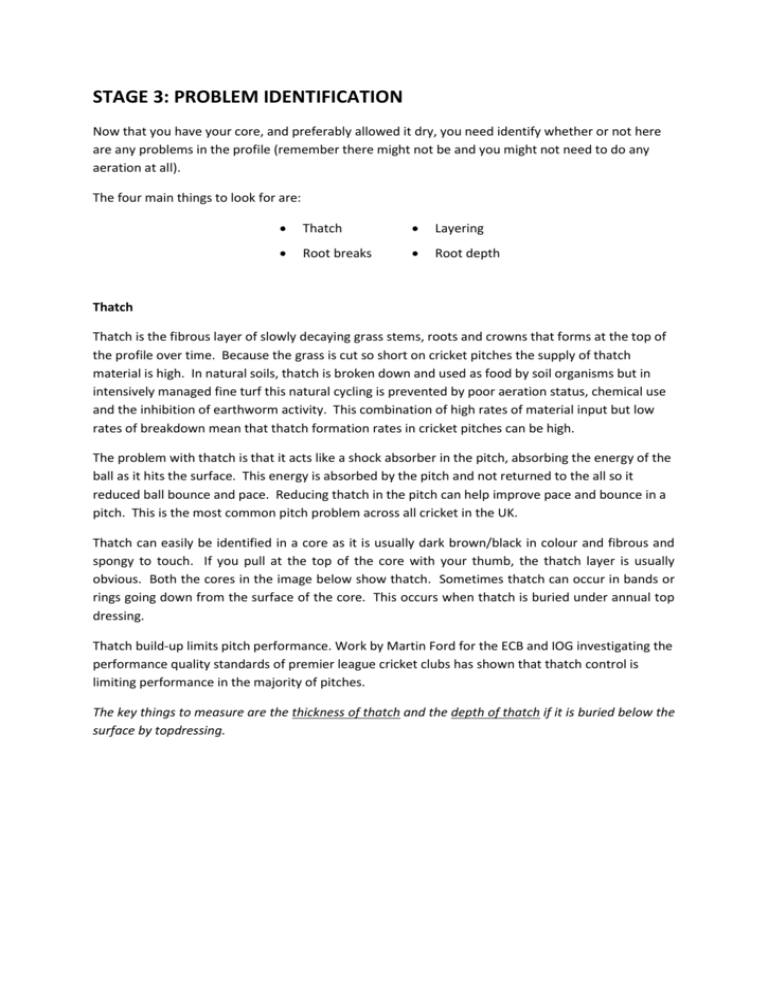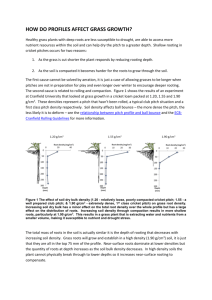5. Stage 3 Problem Identification
advertisement

STAGE 3: PROBLEM IDENTIFICATION Now that you have your core, and preferably allowed it dry, you need identify whether or not here are any problems in the profile (remember there might not be and you might not need to do any aeration at all). The four main things to look for are: Thatch Layering Root breaks Root depth Thatch Thatch is the fibrous layer of slowly decaying grass stems, roots and crowns that forms at the top of the profile over time. Because the grass is cut so short on cricket pitches the supply of thatch material is high. In natural soils, thatch is broken down and used as food by soil organisms but in intensively managed fine turf this natural cycling is prevented by poor aeration status, chemical use and the inhibition of earthworm activity. This combination of high rates of material input but low rates of breakdown mean that thatch formation rates in cricket pitches can be high. The problem with thatch is that it acts like a shock absorber in the pitch, absorbing the energy of the ball as it hits the surface. This energy is absorbed by the pitch and not returned to the all so it reduced ball bounce and pace. Reducing thatch in the pitch can help improve pace and bounce in a pitch. This is the most common pitch problem across all cricket in the UK. Thatch can easily be identified in a core as it is usually dark brown/black in colour and fibrous and spongy to touch. If you pull at the top of the core with your thumb, the thatch layer is usually obvious. Both the cores in the image below show thatch. Sometimes thatch can occur in bands or rings going down from the surface of the core. This occurs when thatch is buried under annual top dressing. Thatch build-up limits pitch performance. Work by Martin Ford for the ECB and IOG investigating the performance quality standards of premier league cricket clubs has shown that thatch control is limiting performance in the majority of pitches. The key things to measure are the thickness of thatch and the depth of thatch if it is buried below the surface by topdressing. Figure 1 Left: a core taken from a poorly performing pitch showing a thatch layer and two root breaks the first one within the same loam and the second one between two layers of different loam. Further down the profile there is a loosely structured layer of loam interfacing with the indigenous soil (sandy loam). Photo courtesy of Chris Wood © ECB 2012. Right: a core taken from a trial pitch at Cranfield University three years after construction. There is a small thatch layer forming already but at less than 5 mm does not affect ball bounce. The core comprises 190-200 mm of uniformly structured clay loam of a single type. The pitch was constructed in approximately 50 mm layers possibly corresponding to the horizontal cracks at 55, 100 and 140 mm, however these do not affect root growth which exceeds the length of the core. Root breaks Root breaks are a complex feature of cricket pitch profiles and are evident in the left hand profile in Figure 1. Root breaks can occur at any depth within the profile but the nearer the surface they are, the more likely they are to affect ball bounce. As the layer forms, grass root growth exploits the large void created, and tends to grow horizontally (Figure 3). This creates a shock absorbing layer that reduces the ball energy on impact and slows the pace and bounce of the pitch. The depth and severity of a root break can vary across the pitch, making it more variable in pace and bounce. To find more about what causes root breaks click here. Figure 2 Identifying problems from cores. (a) This core has two rootbreaks where roots are growing horizontally (at 10 mm and 20 mm). (b) a 'barcode' pitch profile where different loams have been used over different years to dress the pitch. Different loams shrink and swell by different amounts so breaks are caused. (c) this core has two loams (with a boundary at about 40 mm). (e) another barcode profile with different loams used on an almost annual basis; note how there are a number of horizontal breaks in the profile. (f) Another layered profile but with good deep rooting down to 240 mm depth. The key thing to measure is the depth of any root breaks. It can be difficult to identify breaks because sometimes they occur as part of the core taking process, which can fracture cores, particularly as the core is removed. If you suspect a break, take another couple of cores and see whether there is a consistent root break at the same depth or whether it was a one-off. Sometimes if you are not sure whether there is a root break, allowing the core to air dry in a warm room for 48 hours will highlight any breaks as the core dries and shrinks. Figure 3 The effect of root breaks in cricket pitch profiles on grass growth. The root break provides a low resistance path for grass roots to grow when compared to the compacted soil below. Layering Layering occurs when different materials are used to construct or topdress cricket pitches over time. Some cores read a bit like a history of changing groundsmen or loam suppliers, with changes in soil type and colour down through the profile. Provided that each layer is keyed into the next and that there are no rootbreaks, then layering isn’t necessarily a problem. However constructing pitches with different materials can cause significant problems – this is because if they don’t shrink and swell at the same rate they will cause a root break. This is shown in the left hand core in Figure 1, which shows how using two different loams can cause a root break as they shrink and swell different amounts. Always top dress with the loam that your pitches were constructed with. Things to look for: Note the depth and thickness of any organic layers or any layers that are causing root breaks. Root depth Root depth is the easiest one to measure but you might have to break the core up to pinpoint to what depth roots are growing. If you can see roots growing out of the bottom of the core, as per the right hand core in Figure 1, then identifying root depth is easy, otherwise it will be a case of breaking the core apart. There are two ways to do this – one is to slice the core lengthways in two to reveal the roots (take care – cores can be very difficult to cut and there is a risk of injury). The other way is to break the core from the bottom up, removing 10-20 mm each time. In both cases what you are looking for are live roots which tend to be white in colour, and flexible. Older, dead roots tend to be dark brown/red and are more brittle. Look for the depth where the majority of roots grow to. The occasional deep root is not necessarily an indication of healthy rooting – we are looking for lots of deep roots. To find out more about how rooting depth is affected by compaction click here. If you have root breaks then look to see whether roots are growing horizontally and whether they grow any deeper than the root break – this is important because root breaks commonly cause shallow horizontal rooting (Figure 3). The key thing to measure is the depth of rooting. It is also possible to gauge the density of rooting – having one or two deep roots is not as useful as having a greater number (density) of deep roots. Back: Stage 2 – Profile Investigations Next: Stage 4 – Technique and Machinery Selection







